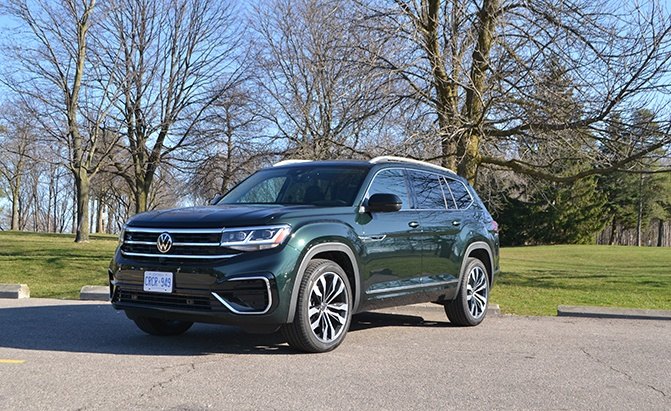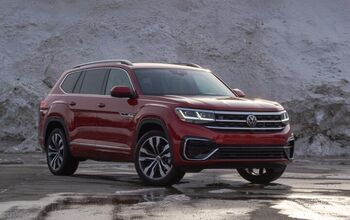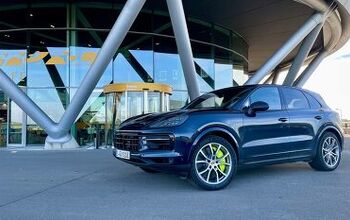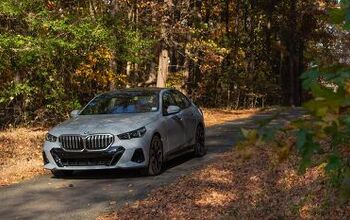2021 Volkswagen Atlas Review: A Passing Grade

FAST FACTS
| Engine: | 3.6L V6 |
| Output: | 276 hp, 266 lb-ft |
| Transmission: | 8AT, AWD |
| US fuel economy (MPG): | 16/22/18 |
| CAN fuel economy (L/100KM): | 14.6/10.9/12.9 |
| Starting Price (USD): | $32,575 (inc. dest.) |
| As-Tested Price (USD): | $46,945 (est, inc. dest.) |
| Starting Price (CAD): | $42,045 (inc. dest.) |
| As-Tested Price (CAD): | $59,235 (inc. dest.) |
If Volkswagen could embody an actor, it would probably be Aaron Eckhart.
Eckhart’s a respectable actor with a decent career and appreciated performances, but yet nothing truly special since well, Thank You for Smoking, which was his Golf GTI. He had a series of good roles over the years. No Reservations and The Dark Knight were clearly Touaregs while Olympus Has Fallen was the Jetta at best. This brings us to the 2021 Atlas, a mid-size three-row SUV built in America for Americans.
Get a Quote on a New Volkswagen AtlasBut among the plethora of options in the mid-size SUV market, where every manufacturer is vying for its own niche, the Atlas stands as the most American looking non-American SUV. Surely it is no I, Frankenstein but does it stand apart enough to be TYFS—or is it another Olympus Has Fallen?
Aesthetic Appeal
Road presence is possibly a primary consideration among SUV buyers and in that aspect at least, the VW Atlas has all its bases covered. At 200 inches (5,036 mm) in length and 78 inches wide (1,978 mm), the Atlas is a sizeable vehicle. Aesthetically, it looks quite imposing and honestly, rather impressive. It stands tall, bold, and square like a traditional SUV. A prominent shoulder line coupled with the flared arches and optional 21-inch wheels further accentuate its stance.
It looks like a vehicle to respect on the road. Mask the badge and you’d be hard-pressed to recognize the Atlas as a European SUV (which technically it isn’t, but the principle still stands). I guess that is possibly one of the primary reasons for its success, that it looks quite American. But unlike a few traditional American SUVs, the large proportions carry over to the cabin.
Living Quarters
Opening the door on our top-of-the-line tester with R-Line package revealed a premium and upscale cabin. Deep Mauro brown perforated leatherette seats contrasted well with the black center console. The design of the dash is quite busy, though. The base of the structure is black soft feel plastic while the top features even softer feel material—also black—with black stitching that runs the length of the whole dashboard. (We’re sensing a theme here. -Ed.)
SEE ALSO: 2020 Volkswagen Jetta Review: All Pumpkin, No SpiceThen there are plastic panels in the brushed aluminum finish that surround the 8.0-inch touchscreen in the middle. A textured panel sits right before the front passenger’s perch, while the aforementioned silver plastic panels also appear on the door panels. The design has a flow to it but there is simply too much going on to view the dash as a whole.
Soft leatherette inserts in the door panels are a nice touch though, and complement the seat upholstery rather nicely. The front perches themselves are quite comfortable and enveloping and provide plenty of under-thigh support. Comfort levels on the rear bench are quite high as well. With 40.4 inches (1,048 mm) of headroom with the panoramic sunroof, there is ample space for even the tallest of passengers. Headroom in the third row drops only by a couple of inches, adequate for average-sized adults, theoretically anyway. The seats on the middle bench are well contoured, supportive, and reclinable barring the middle one. Plus, thanks to the massive glass roof and windows there is a good feeling of space as well.
The third row however, though spacious on paper with 33.7 inches (856 mm) of legroom—four inches (102 mm) less than the middle bench—is best left for children’s use only. Adults will feel the lack of under-thigh support as they will sit with their knees up. Cargo space at little over 20 cu-ft (583 L) is just about adequate for a weekend getaway. With the third row down, it increases to 55.5 cu-ft (1,571 L) and if you fold the middle row as well, which falls flat, you get almost 97 cu-ft (2,741 L) of luggage space. Plus, the middle seat occupants get their own climate control zone and heated seats.
Dials and Screens
For those unfamiliar, we call the instrument cluster dials as well. We used to anyway before the virtual cockpits came along. Volkswagen’s Digital Cockpit, like the one here, adorns the cabins of numerous vehicles under the massive VW umbrella. It’s most stand-out feature of the Atlas’ cabin and also completely customizable. Buttons on the right-hand side of the steering wheel operate the large 10.0-inch screen.
You can cycle through numerous displays via the view button and can have traditional tach and speedo, or even have the entire screen display the navigation map only—an otherwise nifty feature that is let down by the in-built maps. While the maps are detailed and easy to read, I frequently noticed a considerable difference between distance and ETA between Google Maps and the in-built system, which always insisted on going the long way around. Otherwise, the Digital Cockpit is a treat to use, the display is crisp and you can access a plethora of information—though daunting at first—along with the driver assistance systems right from your fingertips.
The infotainment screen could have been bigger, though. With manufacturers now placing massive 12-inchers on the dash, VW is stuck playing catch up. Having said that, the infotainment system works really well, connecting to Apple CarPlay and Android Auto almost instantaneously, and the Bluetooth connection is just as fast. A gripe, though minor, is with the infotainment system, which has touch controls only. Also, the Atlas would greatly benefit from a head-up display that its competitors, like the Mazda CX-9, offer on top trims.
SEE ALSO: Mazda CX-9 vs Toyota Highlander ComparisonLook At It Go
The Atlas we have here is armed with a 3.6-liter V6 but it is also available with a 2.0-liter turbo-four as well. Given the size and heft, the 276 hp and 266 lb-ft of peak torque prove to be just about adequate. The eight-speed box connecting the crank to the wheels can be found elsewhere among the plethora of brands under Volkswagen. At tick over, the engine sounds like it’s from the diesel bloodline but reaffirms its gas lineage once you get on the move.
The gearbox is the same as on the other models and doesn’t feel any different. The response isn’t instantaneous but it’s not laid back either. That would be the throttle mapping. You really need to give the right peddle a good prod to make progress. The climb of the revs is far from urgent, too.
Shift to Sport and the change to the responsiveness is significant and ideal. In Normal mode, the Atlas feels a tad too heavy and laborious but in Sport it feels as it should in Normal mode: lighter on its feet. Burying the throttle still garners the same response from the gearbox as it contemplates life before shifting down two gears, and you’re thrown forward just as you wonder where the power is.
But this dance with the Sport mode tends to cost quite a bit in gas. Driving with a light foot you’re looking at a range of 279 miles (450 km) on a single tank. Respectable, but leaves some more to be desired.
Curves and Bumps
Sport mode makes no difference to the way the suspension is sprung, though. And honestly, it doesn’t really need to. If there’s something VW always tends to get right, it’s the suspension setup, and the Atlas is no exception. It’s no corner carver, yet manages the weight of the vehicle rather well. The Atlas rides well in the city and tends to maneuver quite well despite its size.
The steering is light in the city and weighs up well on the highway. Though it is almost devoid of feedback, it is precise. To be brutally honest, the Atlas isn’t special to drive but does the job it was designed to do, which is to take you, your family, and the dog around town and out for the weekend with minimal fuss, rather well.
Verdict: 2021 Volkswagen Atlas Review
Starting at $32,575 ($42,045 CAD) for the base, the Atlas isn’t exactly affordable, especially in Canada. One clarification here though: the trim nomenclature is quite different in the two markets. So the car we have here is the top Execline with R Line package which is priced at $59,235 CAD. The closest trim in the US would be the SEL R Line which is the penultimate trim and is priced at $46,945. For that price, the only standout feature you get is the immensely customizable 10.0-inch Digital Cockpit.
The Atlas does everything satisfactorily and that is the issue with it. Even after it’s done with its daily grind and weekend duties, it still remains serious and rather single-minded. Its performance is passable, like Eckhart’s as President Benjamin Asher, but could certainly do with a dash of Nick Naylor—or even Harvey Dent.
Become an AutoGuide insider. Get the latest from the automotive world first by subscribing to our newsletter here.
LOVE IT
- Road presence
- Road manners
- Digital Cockpit
LEAVE IT
- Thirsty
- Forgettable driving experience
- The competition offers better features

More by Kshitij Sharma









































Comments
Join the conversation